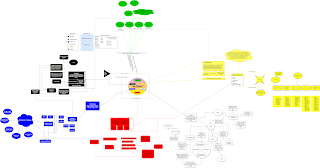I was initially drawn to the “web formed from all the arguments and all the reasons that combine to achieve the desired result” (Perelman “The New Rhetoric” 1396). As Rob and I worked through the readings in the creation of the schema, I kept seeing this web manifest as some sort of Lego structure. Not quite a web, but clicked together, having individual structure and cohesion in the pieces, but being able to snap together into something else with additional meaning. I saw Perelman and Olbrechts-Tyteca breaking down, piece by piece, European continental philosophy in the aftermath of World War II, and then accounting for the pieces they had, and building something like this:
What most struck me with this exercise, and through these readings, if I could start to see the connections from “Dissoi Logoi” and Aristotle, not to mention their connections to philosophy, theology, and other rhetoricians. They did important work in restoring rhetoric as an important place of study, and rehabilitated rhetoric in a modern context. Additionally, this deconstruction and rebuilding of rhetoric and philosophy accounts for epistemology as a social process. As these are done through language, there is a necessary social component to language that is expressed through rhetoric and engaging with rhetoric becomes an epistemological act due to the shifting and revealing of truths, facts, and values. Rhetoric becomes both the blocks that make the dinosaur, and the sign that is the Lego dinosaur.
I found Condit’s feminist and post-modern critiques very useful, especially in examining how fall short Perelman fell given how work they had done. Condit’s noticing of how Perelman and Olbrechts-Tyteca were able to disrupt philosophy/rhetoric binary only replaced it with a rhetoric/new rhetoric binary helps lay the groundwork for a conception of rhetoric that is more adaptive and responsive to multiple situations and for multiple speakers. This critique, grounded in pathos, allows for the disruption of the binaries in speech, between persuasion and logic, between orator and audience, to account for a more nuanced and less marginalizing understanding of rhetoric. Condit reminds us that Aristotle had discussed ethos, pathos, and logos, something that many rhetoricians seem to forget. To quote Condit at length:
The output that has been called “emotion” is always an output that has fused input from multiple circuits that have traditionally been understood as “reason” […] along with linguistic processing centers, along with limbic centers that link to the hormonal outputs we experience in terms of intensity levels of emotions, along with visual, aural, motor, and other activation and input systems through the body (104-5)

No comments:
Post a Comment